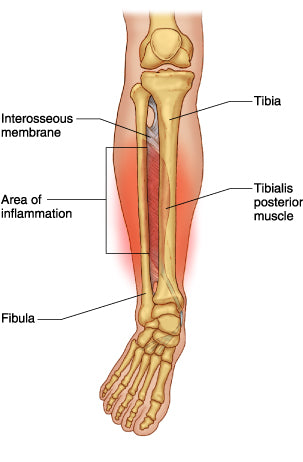Medial Tibial Stress Syndrome (MTSS)
Also know as or related to:
Shin Splints, Tibial Fasciitis, Tibial Periostitis, Compartment Syndrome, Tibialis Anterior Tendonitis, Tibialis Posterior Tendonitis, Tibial stress Fracture and Tibial Stress Reaction.
Description:
Medial Tibial Stress Syndrome is one of the most common injuries experienced by runners. Females are more prone to developing the problem with approximately 20% of females and only 7% of male runners having experienced the condition. The pain is caused by an inflammatory reaction along the inside border of the tibial shaft where the lower leg muscles attach to the bone via a fibrous connective tissue. While running the lower leg muscles are repetitively activated and pull on this fibrous connection. If this load is excessive or the body does not get a chance to recover from this stress it can result in pain and inflammation in this area.
Symptoms:
• A tenderness, pain, or dull ache along the inside, lower 2/3 of the tibia or shin bone.
• The pain is often initially worst at the beginning of a run or exercise improving after warming up.
• The pain is usually only present during exercise and will often resolve after stopping and generally feels significantly better after rest.
• In severe cases the pain can be present even with gentle exercise such as walking; in these severe cases stress fracture of the tibia may be suspected.
Causes:
• Excessive foot pronation is one of the leading causes of Medial Tibial Stress Syndrome. As the foot rolls in the lower leg muscles including the calf are recruited to help reduce and slow the amount the foot pronates. This often results in excessive load on these muscles and consequently micro tears occur along the shin bone where they attach.
• Under pronating, stiff high arched feet are also prone to causing medial tibial stress syndrome as they are not as efficient at absorbing shock which is consequently transmitted into the tibia as the foot strikes the ground.
• Running technique which results in overstriding can lead to increases in ground reaction force which are often poorly absorbed by the tibia and surrounding muscles.
• Excessive body weight increases the shock and load through the lower limb.
• The type of surface you run on can also have a big impact on the severity of the shin pain you experience. Concrete foot paths and bitumen roads don’t provide much natural shock absorption.
• An inappropriate increase in running frequency, mileage or running intensity without adequate recovery leads to too much stress without enough time for the body to adequately repair itself.
• Stiff, tight muscles, poor joint mobility and poor functional strength around the hips, ankles and knees also alter the body’s ability to efficiently absorb shock and stabilise around the joints of the lower limb
Treatment:
Treatment usually involves attacking the problem from several angles to ensure a speedy return to running. Below is an outline of where to begin:
• Reduce the pain and inflammation by using ice and anti-inflammatory medications.
• Reduce weight bearing load by decreasing the distance, frequency and intensity of your runs to allow adequate recovery and repair.
• Re-evaluate your running training plan to ensure you are not progressing too quickly.
• Be assessed by a podiatrist to determine whether your lower limb biomechanics are contributing to the problem.
• Be fitted with the right type of running shoe for your needs to help control excessive foot pronation and aid in shock absorption.
• If necessary use correctly prescribed custom made orthotics to help control poor lower limb biomechanics.
• Have your running technique assessed to help optimise efficiency and reduce excessive ground reaction forces.
• Address any muscular weakness or tightness by stretching and strengthening. Focus on your calf muscles, anterior leg and hip stabilisers. Seek the help of a physiotherapist to help with this.
Summary:
With the right approach Medial Tibial Stress Syndrome can be controlled quickly. Once it has settled it can be prevented by replacing running shoes regularly, incorporating some running drills and technique work into your running program and monitoring your training load ensuring you make time for recovery.
